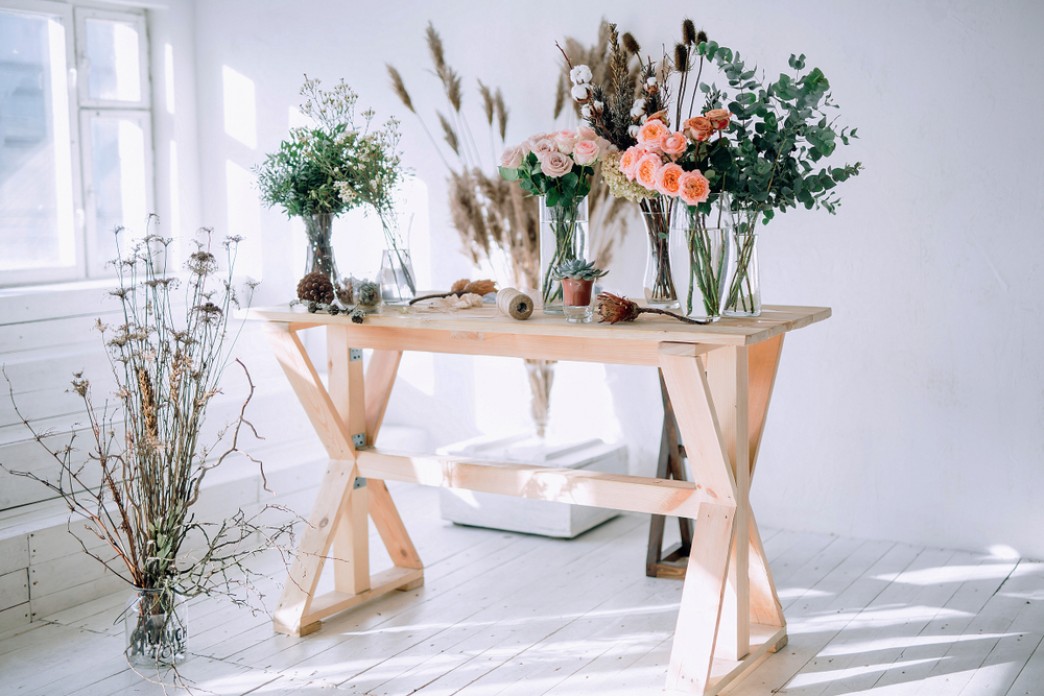With so many moving parts to a funeral, it can be tempting to just let the florist handle the flower arrangements. As long as it’s the perfect sentimental piece, right? But in reality, funeral flowers go much deeper than that. That’s why it’s important to understand the types of funeral flowers and arrangements you can use or give, and what they mean.
Here, we’ve put together the ultimate guide to funeral flowers, and included everything you need to know if you’re in charge of creating a beautiful farewelling for a loved one, or if you’d like to send sympathy flowers to let someone know you share in their grief.
Types of Funeral Flower Arrangements
It only takes one glance at the altar of a typical funeral to know that flower arrangements are not created equally. You might see everything from a small basket of flowers to large, dramatic florals in sweeping designs displayed on stands. We’ve outlined the different types of funeral flower arrangements you can choose from.
Wreath
Funeral wreaths can be breathtakingly beautiful. They can be designed with a variety of flowers, or just one or two types for dramatic effect. The circular shape of a funeral wreath, while hardly unique, is said to represent the circle of life, or eternal life in a religious setting. Wreaths make a great choice for funeral flower arrangements since they’re portable; they can easily be removed from the funeral home and brought to the gravesite to make both places more beautiful.
Cross
A cross is designed similarly to a funeral wreath, only it’s in the shape of a cross instead of a wreath. It’s a popular choice if the person who died was particularly religious.
Casket Spray
Those stunningly beautiful flowers that cascade across the top of a casket? That’s a casket spray, and no funeral seems complete without one. Because this arrangement lies so close to the person who has died, casket sprays are often made of a certain flower (or two) that was particularly meaningful for them. You’ll often hear something like, “Pink roses were Aunt Mary’s favorite” if you inquire about a casket spray. After the burial, it’s customary to leave the casket spray on the gravesite in remembrance. Or, you could offer close family members a single flower from it to have as a keepsake.
Shop Casket Spray Funeral Flowers
Easel Spray
An easel spray is likely the first thing that comes to mind when you think of funeral flowers. It’s the dramatic floral display that sits on an easel. These beautiful arrangements are often made of the most popular types of funeral flowers, like roses, lilies and carnations. Note, however, that they’re best viewed from the front only, since they’re made to rest flat against an easel. So if the funeral calls for a more 360-degree arrangement, you might want to opt for a basket or vase of flowers.
Shop Easel Spray Funeral Flowers
Basket
One of the most versatile funeral flower arrangements, a basket is the perfect way to honor someone who has died. Typical basket arrangements are composed of flowers that represent death or are common at funerals, like lilies or gladiolus. They can range in size from very large to very small, and are quite portable, too.
Types of Funeral Flowers
Wondering what types of buds to use on all those beautiful funeral flower arrangements? There’s more to it than you might think! While there aren’t many hard and fast rules (though there are some cultural guidelines to consider), there are certain flowers that are used more commonly than others at funerals.
Lily
The lily is one of the most common flowers that represent death. As such, you’d be hard-pressed to attend a funeral without seeing a lily. According to 1-800-Flowers, “white lilies symbolize innocence, the rebirth of the soul, and purity.”
Carnation
These florals are as inexpensive as they are pretty, which makes them the perfect choice for large floral displays that contain a variety of flowers. When it comes to carnations, white is symbolic of innocence, red is said to refer to love and admiration, and pink is the color of remembrance.
Gladiolus
These tall flowers are great for sprays, where flowers of differing heights come together to create a visually stunning arrangement of sympathy flowers. These pretty flowers that come in a bunch of bright shades are said to indicate strength of character, a wonderful compliment to the person who has died.
Rose
One of the most popular flowers in the world, the rose certainly has a place among flowers that represent death. The deep red is symbolic of sorrow, and is often seen in funeral flower arrangements, along with white roses, which symbolize innocence.
Flower Colors and Their Meanings
If it seems like the same colors keep popping up at funerals over and over, it's because these colors tend to hold meaning when they're used as part of funeral flower arrangements—sympathy flowers, so to speak. Below, we'll take a look at some of the most common colors florists use when arranging flowers to be used as remembrance for funerals.
- White: Whether used alone or in conjunction with another color, white flowers are the most commonly used funeral flowers. Not only do white flowers tend to mean innocence and purity, it so happens that almost all of the most commonly used flowers at funerals—lilies, roses, carnations and mums—can be white.
- Red: Red flowers, especially deep, velvety reds like roses, conjure thoughts of love and grief. Roses are a popular choice for funerals, but you could also opt for dramatic red mums or red carnations.
- Yellow: Yellow is a color that's universally associated with friendship. Think this cheery color is a no-go for a funeral? Think again! Many of the most touching arrangements have at least a splash of yellow mixed in. Yellow gladiolus are particularly apropos for funeral flowers.
- Lavender: Meaning respect and humility, lavender flowers make a lovely choice as part of a funeral flower arrangement.
- Blue: The color of sorrow, there's always a place for blue flowers when you're selecting sympathy flowers. Delphinium and larkspur are popular options.


-banner.png)





